Related Research Articles

Washington Irving was an American short-story writer, essayist, biographer, historian, and diplomat of the early 19th century. He is best known for his short stories "Rip Van Winkle" (1819) and "The Legend of Sleepy Hollow" (1820), both of which appear in his collection The Sketch Book of Geoffrey Crayon, Gent. His historical works include biographies of Oliver Goldsmith, Muhammad and George Washington, as well as several histories of 15th-century Spain that deal with subjects such as Alhambra, Christopher Columbus and the Moors. Irving served as American ambassador to Spain in the 1840s.

Alexander Hamilton was an American revolutionary, statesman and Founding Father of the United States. He was an influential interpreter and promoter of the U.S. Constitution, and was the founder of the Federalist Party, the nation's financial system, the United States Coast Guard, and the New York Post newspaper. As the first secretary of the treasury, Hamilton was the main author of the economic policies of the administration of President George Washington. He took the lead in the federal government's funding of the states' American Revolutionary War debts, as well as establishing the nation's first two de facto central banks, a system of tariffs, and the resumption of friendly trade relations with Britain. His vision included a strong central government led by a vigorous executive branch, a strong commercial economy, support for manufacturing, and a strong national defense.
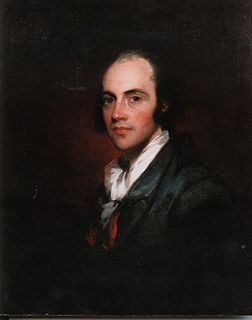
Aaron Burr Jr. was an American politician and lawyer who served as the third vice president of the United States from 1801 to 1805. Burr's legacy is defined by his famous personal conflict with Alexander Hamilton that culminated in Burr killing Hamilton in a duel in 1804, while Burr was vice president.
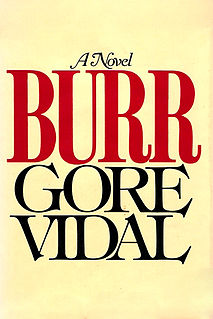
Burr is a 1973 historical novel by Gore Vidal that challenges the traditional Founding Fathers iconography of United States history, by means of a narrative that includes a fictional memoir by Aaron Burr, in representing the people, politics, and events of the U.S. in the early 19th century. It was a finalist for the National Book Award in 1974.
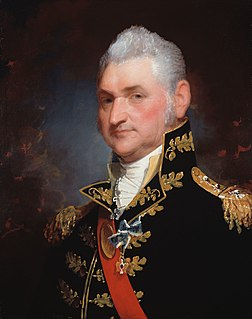
Henry Dearborn was an American military officer and politician. In the Revolutionary War, he served under Benedict Arnold in his expedition to Quebec, of which his journal provides an important record. After being captured and exchanged, he served in George Washington's Continental Army. He was present at the British surrender at Yorktown. Dearborn served on General George Washington's staff in Virginia.

The Sketch Book of Geoffrey Crayon, Gent., commonly referred to as The Sketch Book, is a collection of 34 essays and short stories written by the American author Washington Irving. It was published serially throughout 1819 and 1820. The collection includes two of Irving's best-known stories, attributed to the fictional Dutch historian Diedrich Knickerbocker: "The Legend of Sleepy Hollow" and "Rip Van Winkle". It also marks Irving's first use of the pseudonym Geoffrey Crayon, which he would continue to employ throughout his literary career.

The Burr–Hamilton duel took place in Weehawken, New Jersey, between Aaron Burr, the Vice President of the United States, and Alexander Hamilton, the first and former Secretary of the Treasury, on the morning of July 11, 1804. The duel was the culmination of a bitter rivalry that had developed between both men who had become high-profile politicians in postcolonial America. In the duel Burr fatally shot Hamilton, while Hamilton fired into a tree branch above and behind Burr's head. Hamilton was taken back across the Hudson River and died the following day in New York.
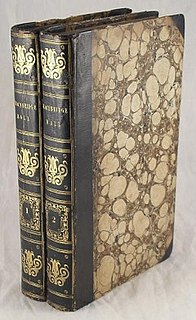
Bracebridge Hall, or The Humorists, A Medley was written by Washington Irving in 1821, while he lived in England, and published in 1822. This episodic novel was originally published under his pseudonym Geoffrey Crayon.
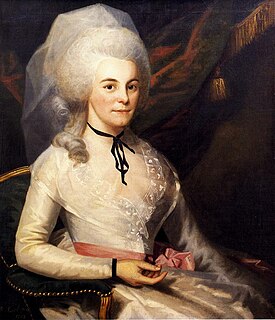
Elizabeth Hamilton, also called Eliza or Betsey, was an American socialite and philanthropist. Married to American Founding Father Alexander Hamilton, she was a defender of his works and co-founder and deputy director of Graham Windham, the first private orphanage in New York City. Eliza is recognized as an early American philanthropist for her work with the Orphan Asylum Society.

Salmagundi; or The Whim-whams and Opinions of Launcelot Langstaff, Esq. & Others, commonly referred to as Salmagundi, was a 19th-century satirical periodical created and written by American writer Washington Irving, his oldest brother William, and James Kirke Paulding. The collaborators produced twenty issues at irregular intervals between January 24, 1807 and January 15, 1808.

Richmond Hill was a colonial estate in Manhattan Island, that was built on a 26-acre (110,000 m2) parcel of the "King's Farm" obtained on a 99-year lease in 1767 from Trinity Church by Major Abraham Mortier, paymaster of the British army in the colony. Part of the site is now the Charlton-King-Vandam Historic District of Manhattan's Hudson Square neighborhood.

William Coleman was the first editor of The New York Evening Post, chosen by founder Alexander Hamilton.
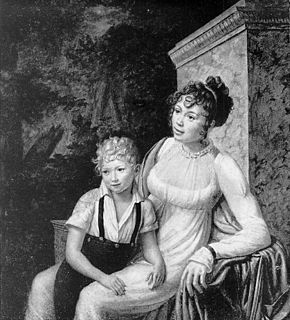
Leonora Sansay was an American novelist. She was the author of Secret History; or, The Horrors of St. Domingo, in a Series of Letters Written by a Lady at Cape Francois to Col. Burr, late Vice-President of the United States, Principally During the Command of General Rochambeau and Laura, and possibly three other novels: Zelica: The Creole ; The Scarlet Handkerchief ; and The Stranger in Mexico.
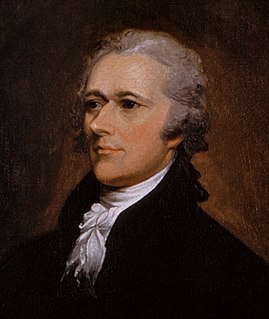
The Hamilton–Reynolds affair was the first major sex scandal in American political history. It involved Secretary of the Treasury Alexander Hamilton, who conducted an affair with Maria Reynolds from 1791 to 1792, during the presidency of George Washington. When he discovered the affair, Reynolds' husband, James Reynolds, subsequently blackmailed Hamilton over the affair, who paid him over $1,300; about a third of his annual income, to maintain the secrecy. In 1797, Hamilton publicly admitted to the affair after his political enemies attacked and accused him of financial corruption during his time as the Treasury Secretary. Hamilton responded by stating, "The charge against me is a connection with one James Reynolds for purposes of improper pecuniary speculation. My real crime is an amorous connection with his wife, for a considerable time with his privity and connivance."
American Citizen was an influential newspaper in New York City in the early 19th century. It advocated against Aaron Burr in his 1804 run for governor of New York.
Peter Irving was an American physician, author, and politician who was the brother of Washington Irving, William Irving and John T. Irving.

Hamilton is a sung-and-rapped-through musical by Lin-Manuel Miranda. It took over seven years to compose. It tells the story of American Founding Father Alexander Hamilton. Miranda said that he was inspired to write the musical after reading the 2004 biography Alexander Hamilton by Ron Chernow. Miranda says Hamilton was originally a hip hop album in his head. The show draws heavily from hip hop, as well as R&B, pop, soul, and traditional-style show tunes. It casts non-white actors as the Founding Fathers of the United States and other historical figures. Miranda described Hamilton as about "America then, as told by America now."
George I. Eacker was a New York lawyer. He is best known for having fatally shot Philip Hamilton, the eldest son of Alexander Hamilton and Elizabeth Schuyler Hamilton, in a duel on November 23, 1801, in Weehawken, New Jersey.

Philip Hamilton was the eldest child of Alexander Hamilton, the first U.S. Secretary of the Treasury, and Elizabeth Schuyler Hamilton. He died at age 19, fatally shot in a duel with George Eacker.
A History of New York, subtitled From the Beginning of the World to the End of the Dutch Dynasty, is an 1809 literary parody on the history of New York City by Washington Irving. Originally published under the pseudonym Diedrich Knickerbocker, later editions that acknowledged Irving's authorship were printed as Knickerbocker's History of New York.
References
- Irving, Pierre M. Life and Letters of Washington Irving. 4. vols. (Putnam, 1860)
- Irving, Washington. "Letters of Jonathan Oldstyle, Gent./Salmagundi." The Complete Works of Washington Irving, Volume 6. Edited by Bruce Granger & Martha Hartzog. (Twayne, 1977) ISBN 0-8057-8509-4
- Jones, Brian Jay. Washington Irving: An American Original (Arcade, 2008) ISBN 978-1-55970-836-4
- Williams, Stanley T. The Life of Washington Irving. 2 vols. (Oxford University Press, 1935)
Notes
- ↑ Irving, Letters of Jonathan Oldstyle, 3-4
- ↑ Ibid.
- ↑ Ibid, 5-7.
- ↑ Ibid.
- ↑ Jones, 21-22
- ↑ Irving, Letters of Jonathan Oldstyle, 20
- ↑ Explanatory Notes, Letters of Jonathan Oldstyle, 47
- ↑ Ibid
- ↑ Irving, Letters of Jonathan Oldstyle, 27-31
- ↑ Jones, 22
- ↑ Irving, Letters of Jonathan Oldstyle, 34
- ↑ Ibid, 35
- ↑ Jones, 20
- ↑ Memoirs of Aaron Burr, with Miscellaneous Selections of His Correspondence, ed M.L. Davis (New York, 1837); cited in Letters of Jonathan Oldstyle, 40n5
- ↑ Jones, 21
- ↑ Historical Note, Letters of Jonathan Oldstyle, 41
- ↑ Pierre M. Irving, Life and Letters of Washington Irving, I,48
- ↑ Letters of Jonathan Oldstyle, Gent. By the Author of The Sketch Book. With a Biographical Notice. New York and London, 1824,)
- ↑ Washington Irving and the House of Murray, ed. Ben Harris McClary, (Knoxville, Tenn., 1969), 53
- ↑ Textual Commentary, Letters of Jonathan Oldstyle, 50-55